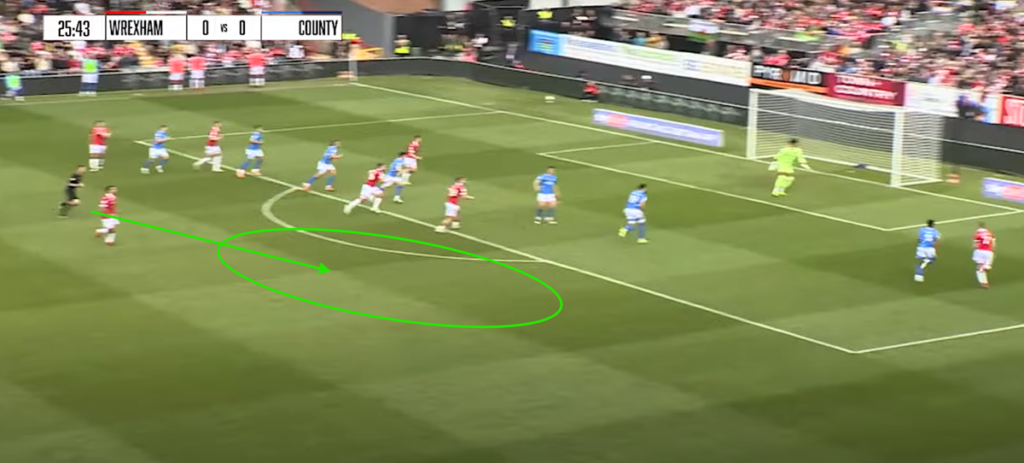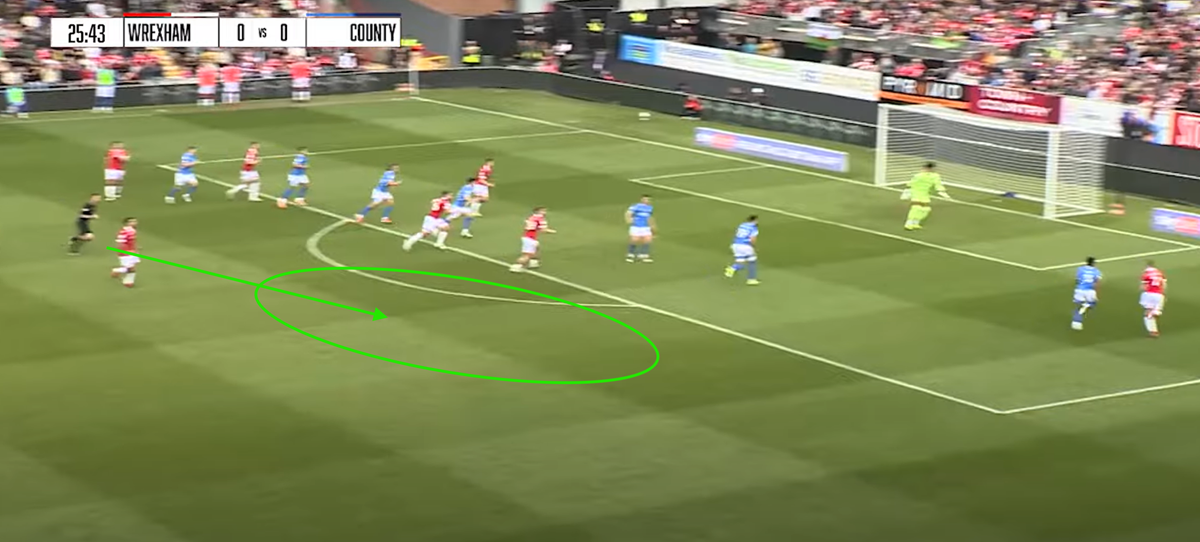They who scream loudest
Wrexham v Stockport | Sat 22 March 2025
This penalty decision has caused a bit of a stir amongst fans and referees alike. And when that happens, there’s usually cause to question the outcome. However, the outcome is rarely black and white.
Watch the clip, then we’ll talk more below:
The sequential facts
- A defender and an attacker are competing for a high ball in the penalty area
- There is contact between the players, with the arm of the attacker high on the defender’s back
- The defender, whilst off the ground, falls forward and their arm elevates above shoulder height
- The ball hits that defender’s arm raised above shoulder height
- The attacker animatedly gesticulates handball at the Referee
- The attacker approaches and shouts at the Assistant Referee
- After some delay, the Referee and Assistant Referee confer* and award a penalty
*Writing this, we do not know what was discussed
There’s a few critical talking points: Is it a handball offence? Was there a foul on the defender? Have the officials only given it because the player has screamed at them?
Handling the ball
We’ll start with handball, because reviewing law should make it easy to agree on in principle… shouldn’t it?
It is an offence if a player:
- deliberately touches the ball with their hand/arm, for example moving the hand/arm towards the ball
- touches the ball with their hand/arm when it has made their body unnaturally bigger. A player is considered to have made their body unnaturally bigger when the position of their hand/arm is not a consequence of, or justifiable by, the player’s body movement for that specific situation. By having their hand/arm in such a position, the player takes a risk of their hand/arm being hit by the ball and being penalised
The questions you may ponder…
- Can it be considered a deliberate handball when the player has their back turned?
Probably not - Is there a clear movement of the hand/arm towards the ball?
Doesn’t appear to be - Has the arm made the body unnaturally bigger?
Yes! An arm raised above shoulder height may be considered precisely that
However, law allows for context and mitigating factors. I.e. It is only an offence if “the position of their hand/arm is not a consequence of, or justifiable by, the player’s body movement for that specific situation.”
So, is there justification for the player’s arm being high above the shoulder? That takes us onto…
Was there a foul on the defender?
Perhaps. Perhaps not. The attacker clearly leans into the defender challenging for the ball, but the defender is moving into the attacker’s personal space. Is the physical challenge from either player considered unfair or excessive as they approach they approach the ball, or do they equally contribute to the coming together.
The potential escalation from fair contact to foul play comes as the defender jumps to head the ball. The attacker leans and extends their arm forward into the defender’s upper back. Once airborne, it’s difficult for the defender to compete physically against being pushed. As a consequence, the defender falls forward and their arm flails high. Still, was contact enough to call foul play, or is it just football contact?
All said, does it even matter whether the challenge involved foul play or not^. Either way, the physical challenge contributes to the elevated arm, thus arguably making the position of the arm justifiable for that specific situation?
Why was it only after they were screamed at?
First things first, players will always appeal about decisions faster than referees can take action. The idea that referees make decisions because “they asked for it” is unfair, but holds a semblance of truth.
Note. Screaming and gesticulating is unacceptable. We would expect a strong public rebuke as a minimum. Best practice would require a caution.It can be good practice to wait a moment before making a decision; to see if play can continue unhindered, or play an advantage. Or, if a decision is on the fence – such as the above, to seek support of your match officials, consider reactions, and gauge expectations.
That said, in any “wait and see scenario”, there should be some kind of communication delivered relatively quickly to settle any appeals. Of course, there may have been mitigating factors – perhaps the comms kits failed to work! But on this occasion, the optics are that the decision was made because of the appeals. That is not a good look.
How could this have been avoided?
We can’t comment on the process and communication between the match officials because that would be conjecture.
However, we can look at the referee’s positioning on the field of play, as to facilitate a more complete picture and better control over the situation from a more credible position.
From the touchline, the Assistant Referee only has one angle available. Whilst the contact of the ball on an arm above shoulder height is likely very apparent, the physical challenge that contributes to the arm’s position is less so, thus the Assistant is unable to consider justification or mitigating factors for the arm’s position, or possible foul play.
Had the Referee moved further right as the ball was played long from the midfield, he would have a better view of both the physical challenge in the dropping zone, and of the impact of the ball on the arm. This fuller awareness would have given the referee the insight required to make a faster and more confident decision.

Of course, we can’t be certain what the referee’s decision would have been from this position, but it would have provided more clarity on the options available to him:
- “Penalty! I’ve seen the handball. The arm’s far too high”
- “No penalty! Calm down James (attacker), he’s just fallen forwards from the challenge”
NB. It may be challenging to restart with a corner; stating the handball is a consequence of something you don’t consider foul play - “No penalty! Calm down James (attacker), you pushed him forward”
^Giving the soft defensive freekick supports your decision to not award a penalty



Leave a Reply
You must be logged in to post a comment.